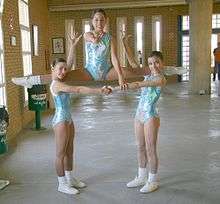Aerobic gymnastics

Aerobic gymnastics or sport aerobics is a competitive sport originating from traditional aerobics in which complex, high-intensity movement patterns and elements of varying difficulty are performed to music. In addition to aerobics, it combines elements of acrobatic gymnastics, rhythmic gymnastics and often artistic gymnastics along with music, dance and choreography.
Nature of the game
The performance area is 7 metres (23 ft) square for juniors or 10 metres (33 ft) square for adults and for aero dance. Performers fit into divisions: junior divisions, made up of primary and secondary teams; novice divisions, including individual men and women; intermediate divisions made up of individual men and women, mixed pairs and trios; and elite divisions including individual men and women, mixed pairs and trios. A three-person team may be made of any combination of men and women in a trio. Step teams and general divisions also exist.
In International competition there are 7 different events: Individual Women, Individual Men, Mixed Pairs, Trios, Group (five athletes), Step and Dance (both eight athletes). The last four are regardless of the Genders of the athletes.
The performances are made up of the following elements: dynamic strength, static strength, jumps and leaps (power), kicks (dynamic strength), balance and flexibility. The routine must be performed entirely to music. Three exercises are mandatory: four consecutive high leg kicks, four consecutive push-ups, and a phase beginning with four jumping jacks and comprising 32 counts of standing movements and patterns. Additionally, a maximum of ten elements from following families are allowed: push-ups, supports and balances/holds, kicks and splits, jumps and leaps. Some movements in other gymnastic sports (sport acrobatics, artistic gymnastics, rhythmic gymnastics, etc.) are now allowed, such as handsprings, handstands, acrobatic flips, and aerial somersaults, both in FIG program as well as in FISAF.
In the competition, women are required to wear a one-piece leotard, shimmer tan tights, white socks and white runners, with their hair in a tight bun. Men must wear a unitard or body shorts and form fitting lycra shirts. Sometimes, men wear tights for warmth or for aesthetic reasons. Those clothes are often intricately designed with bright colour.
Performances are scored according to artistic quality, creativity, execution and difficulty. Artistic quality is the composition of the routine. Creativity is the variety of movements, lifts in pairs, trios and groups. Execution is the perfection of each movement. Difficulty is the number of required gymnastic elements demonstrating strength, flexibility, power and local muscular endurance.
Competitive aerobic gymnastics
FIG aerobics
The competitive aerobic gymnastics are governed by the Fédération Internationale de Gymnastique (FIG). The FIG designs the Code of Points and regulates all aspects of international elite competition. Within individual countries, gymnastics is regulated by national federations. In 1995, the FIG recognised sport aerobics as a new competitive gymnastics discipline, organised judges and coaches courses and launched the 1st Aerobic Gymnastics World Championships in Paris (34 countries). In 1997, the IWGA (International World Games Association) included Aerobic Gymnastics in its programme of the 5th World Games (Lahti, Finland).[1] Since 1999 The European Union of Gymnastics has been conducting Aerobic European Gymnastics Championships in all uneven years.[2] Leading nations who have provided World Medallists are: Australia, Brazil, Bulgaria, Chile, China, France, Hungary, Italy, Japan, Korea, New Zealand, Romania, Russia and Spain.[1]
FISAF aerobics
The Federation of International Sports, Aerobics and Fitness (FISAF) is an international non-profit "umbrella organization" active in over 40 countries. It is self-described as "the largest fitness industry organisation in the world" and "the largest instructor certification agency in the world".
Besides offering training and accreditation, the Federation of International Sports, Aerobics and Fitness used to host a variety of national-and international-level sports aerobics competitions leading up to an annual World Championship. Currently FISAF is focused more on Hip-hop dances and Sport Aerobics events are not common.[3]
National Aerobic Championships
The National Aerobic Championships is a competition of Aerobic Gymnastics started in 1984 in the United States. Founded by Sport Fitness International it was the first major championships in the sport predating the Aerobic Gymnastics World Championships by 11 years. From 1988 onwards the Individual events were separated by gender.
References
- 1 2 Federation Internationale de Gymnastique Archived July 5, 2009, at the Wayback Machine. History of Aerobic Gymnastics
- ↑ European Union of Gymnastics History of Aerobic Gymnastics
- ↑ FISAF World Championships
External links
| Wikimedia Commons has media related to Aerobic gymnastics. |
- The Association of National Aerobics Championships (ANAC)
- Federation of International sport aerobics & Fitness Inc. (FISAF)
- Video of Roberson Magalhaes in World Championship 2002
- Video of Jonatan Canada, FIG World Champion 2002
